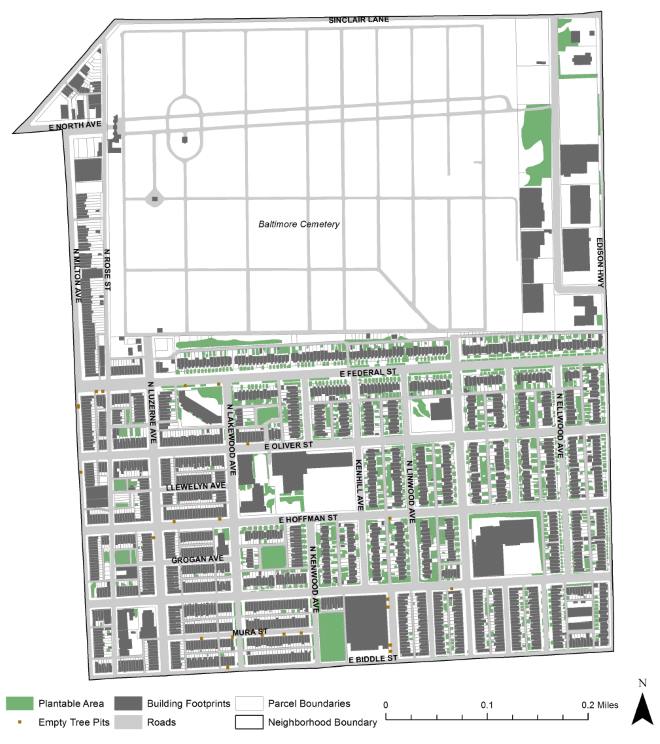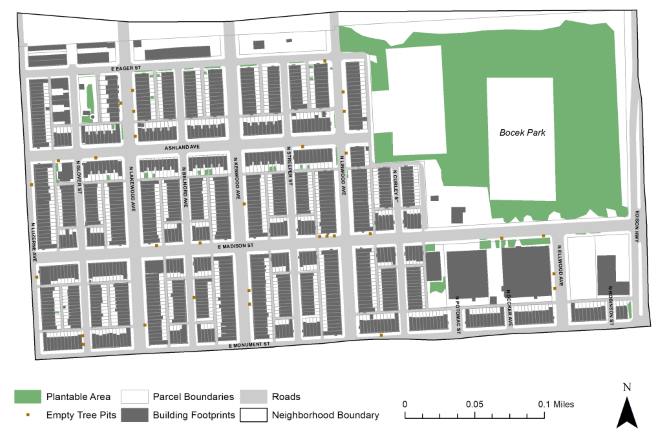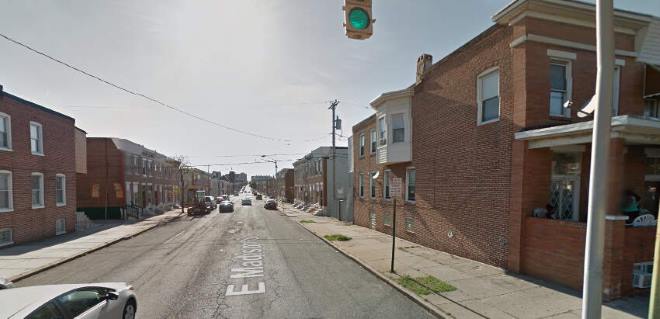Trees must feature heavily within urban environments, if the adverse impacts of man-made and artificial landscapes are to be lessened in magnitude. However, in many instances, tree cover is not where it could be. Roadside verges may be void of trees (even those that are rather wide) and other public areas may also be somewhat lacking in tree cover. In an attempt to counteract the harshness of the urban environment, many local authorities (public bodies) are stating their desire to improve the tree cover within their realms, or at least make areas more ‘green’. Many suitable areas likely exist to feasibly support such a pursuit, though what is straightforward on paper may not be so in actuality.
In this post, we focus on a case study undertaken in the tree-lacking and intermittently concrete-laden East Baltimore, where the municipal authority is seeking to double the city’s tree cover over the coming years (to 40% canopy cover). Specifically, the study looks at two areas of East Baltimore (Madison-Eastend and Berea), where tree planting en masse is potentially possible (due to a current lack of trees – only one tree for every 83m and 62m of street, respectively!) though, since the 1960s, planting schemes there have routinely failed (at the time, many residents were in opposition to tree planting).
In fact, residents in East Baltimore during the 1960s preferred clean concreted areas, and considered trees to be directly in opposition to their values. Locally, they were dubbed “tree rebels”. Since then however, the population of East Baltimore has drastically altered. Gone is the largely European immigrant population, and in its place is a growing community of African Americans that moved in from rural areas. The lack of trees has remained, however. In addition, to reach the 40% canopy cover desires it has been recognised that residents must also start to plant trees in their gardens, as planting street and park trees alone will not enable East Baltimore to reach its target goal of canopy cover. Below, we can observe a broad break-down of existing canopy cover and potential future canopy cover levels if tree planting is successfully completed.

The authors therefore have two (or three) principal questions to answer: (1) is there ample space to support “aggressive” tree planting regimes, and (2) do current residents of the two areas want more trees and, even if they do, are they willing to support planting schemes. A third question builds on the second one a little, and asks whether the changing ethnic composition of the areas has an influence upon desires relating to tree presence and planting. Madison-Eastend and Berea were selected as areas for the study, as they are near to where the principal “tree rebel” groups were, and are also suitable for accomodating a large-scale increase in tree presence. The two areas also vary enough in terms of house ‘plot’ size (property and surrounding garden) and available public green space (Madison-Eastend is lacking significantly within properties and along roadways, and Berea is most certainly not), which enables for views to be obtained across a wider spectrum. Granted, both areas have ample potential space for trees (as shown below, in the two figures).


In order to obtain the data for the study, the authors interviewed 16 residents from Berea and 10 from Madison-Eastend. The interviews lasted for roughly 15 minutes, and had some form of structure, though did allow for interviewees to diverge from the interview and expand upon other tree-related issues if they so desired. All interviewees were African American.
Upon completion, 14 of the 26 interviewees held a generally positive perception of trees. The authors remark that the shading benefits of trees was particularly valued in Madison-Eastend, given the area (and Baltimore as a whole) has a potentially uncomfortably warm and generally humid subtropical climate (exacerbated by the lack of trees, no doubt). For those interviewed in Madison-Eastend who did not have access to shaded locations, the desire for larger trees to bring shade to the area directly outside of properties was particularly evident. If such areas were not available, or even if they were, interviewees would “gravitate” to the side of the street that did not receive direct sunlight. In Berea, interviewees echoed sentiments from those in Madison-Eastend, and even whilst a few streets did already have large trees that cast shade, it was recognised that the urban heat island effect was an issue area-wide as a whole. Remarks were also made as to tree shade reducing costs associated with running air-conditioning systems.

Other positive values held by residents interviewed included the amenity value trees provided and their beneficial impacts upon tackling climate change (or just generally improving the environment, because trees are needed for humans to live).
Turning towards negatives, interviewees (even those who generally liked trees) stated that the wildlife attracted by trees was annoying – bird poor was a principal nuisance, though insects and also rats were raised as concerns residents had. Tree pollen and its associated allergies was also a concern outlined, with one interviewee stating they didn’t want to have to start taking tablets again to combat their allergic reactions. However, quite selflessly, one interviewee stated that they would champion large-scale tree planting operations, even in spite of their allergic reaction to pollen. A necessary trade-off, they claimed.
Overhanging branches and roots entering drain pipes were also issues raised. An interviewee in Berea, for example, exclamated that they did not want trees because of the issues with roots in water pipes. Similarly, an interviewee from Madison-Eastend used an example of vacant properties with tree branches encroaching upon them to outline why trees may be bad. Falling limbs in storms was also a concern, of which limbs from large trees were particularly an issue.
Echoing past planting failures, one resident in Madison-Eastend stated that they had watched trees die before, so questioned why the city hadn’t cared for previous trees planted. Perhaps, the same thing will just happen again, they assume. Where dead trees still remained, residents also wished that East Baltimore authorities would remove the dead ones before stating they want to plant more, as the dead trees were not amenable and, in some cases, had been left for over a year without removal.
On a more profound level, one resident interviewed was concerned that tree planting en masse would lead to gentrification of the area, meaning a potential destruction or displacement of the community they had grown up within. On a similar note, political agendas were a concern, where trees may simply be planted to further the career of a politician. Drug issues were also a concern, as trees could be a place to hide drugs (that residents were keen to stop occurring at the current high drug-use rates). However, no remarks were made on the concrete landscape being more preferable than one with trees, in contrast to the 1960s era of “tree rebels”.
Focussing on aftercare of trees, views were mixed. Some who were interviewed said they would care for the trees, though were concerned other residents nearby would not (or even if they did, children may break them). Others stated that, as so many trees had died before, they were lacking the confidence in any future tree planting schemes being any different. It was also mentioned that whilst homeowners may water trees, those who rent may not (because homeowners have a greater vested interest in the area surrounding their property). Changing culture was also cited as a reason for why aftercare undertaken by residents may be poor. Whilst the initial wave of African Americans was from rural areas who had a closer affinity with nature, the current younger generation grew up in the concreted city landscape. Therefore, would they even care for trees and nature in the same way as the older generation do?
In light of the results from the interviews, we can observe how there are mixed views on tree planting and the associated aftercare by residents. Whilst trees bring shade and look good, they may cause mess, not be loved by renters in the same way they may be by homeowners, and be viewed as a vehicle for furthering political agendas. However, because no interviewees stated they preferred concrete landscapes, the views from the 1960s may no longer be held (though we must accept this was a very limited sample size). From this, we can suggest that tree planting to any large degree is far more of a possibility than it once was, and it may be wise to try again. It should also be noted that all points raised both for and against trees were also entirely valid, and would probably be relatively similar for other areas across the western world. Of course, it then comes down to balancing those values aforementioned, and ensuring that current negative views of trees are challenged in a constructive and informative manner. If this can be achieved, the goal of 40% tree cover across Baltimore may become a more achievable dream.
Source: Battaglia, M., Buckley, G., Galvin, M., & Grove, M. (2014) It’s not easy going green: obstacles to tree-planting programs in east Baltimore. Cities and the Environment (CATE). 7 (2). Article 6.
To discuss this post, please leave a message below or head over to Arbtalk and leave a post there.
